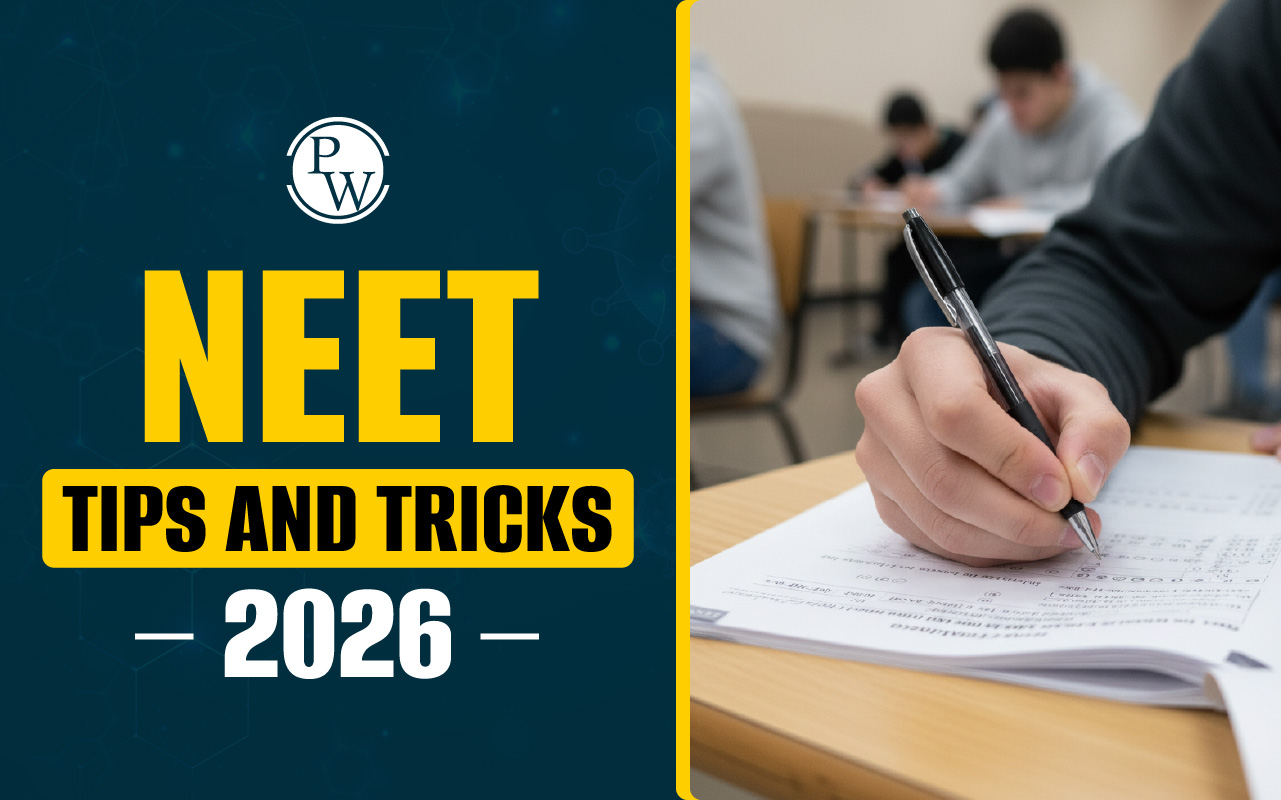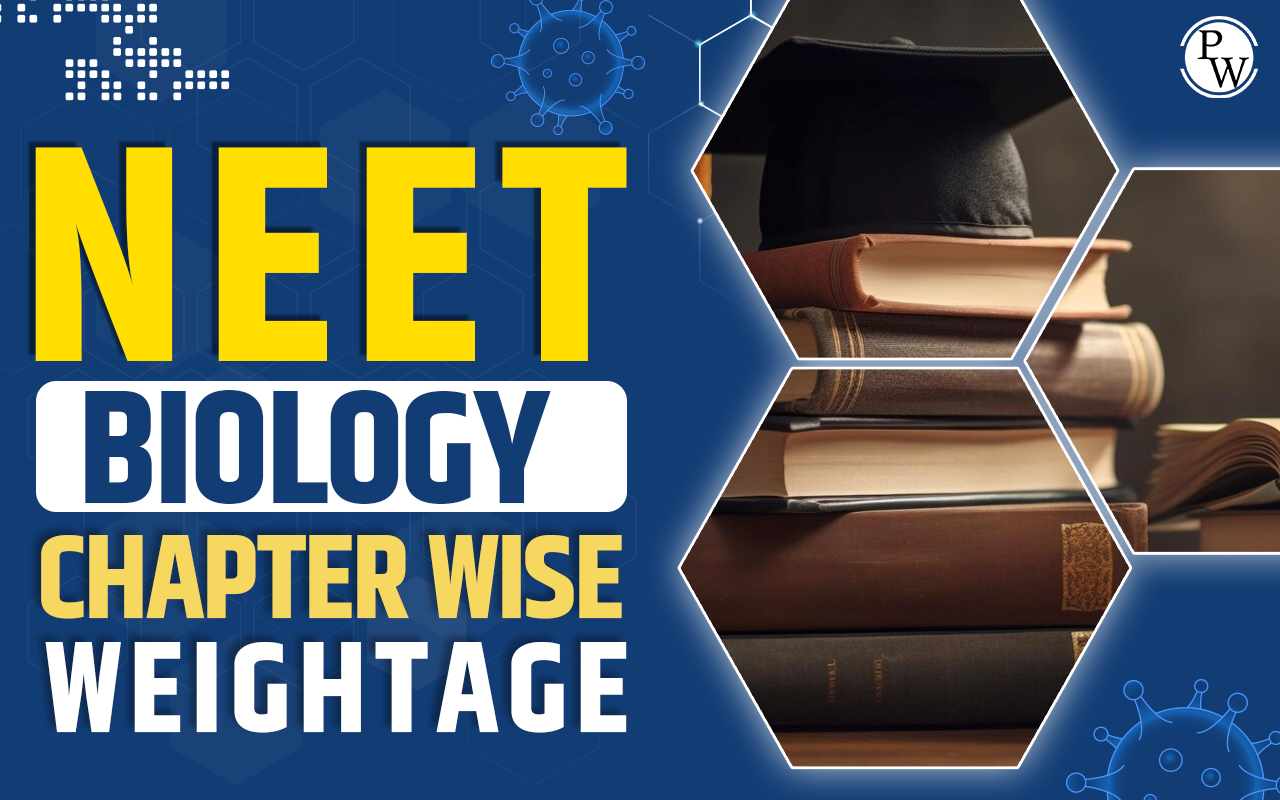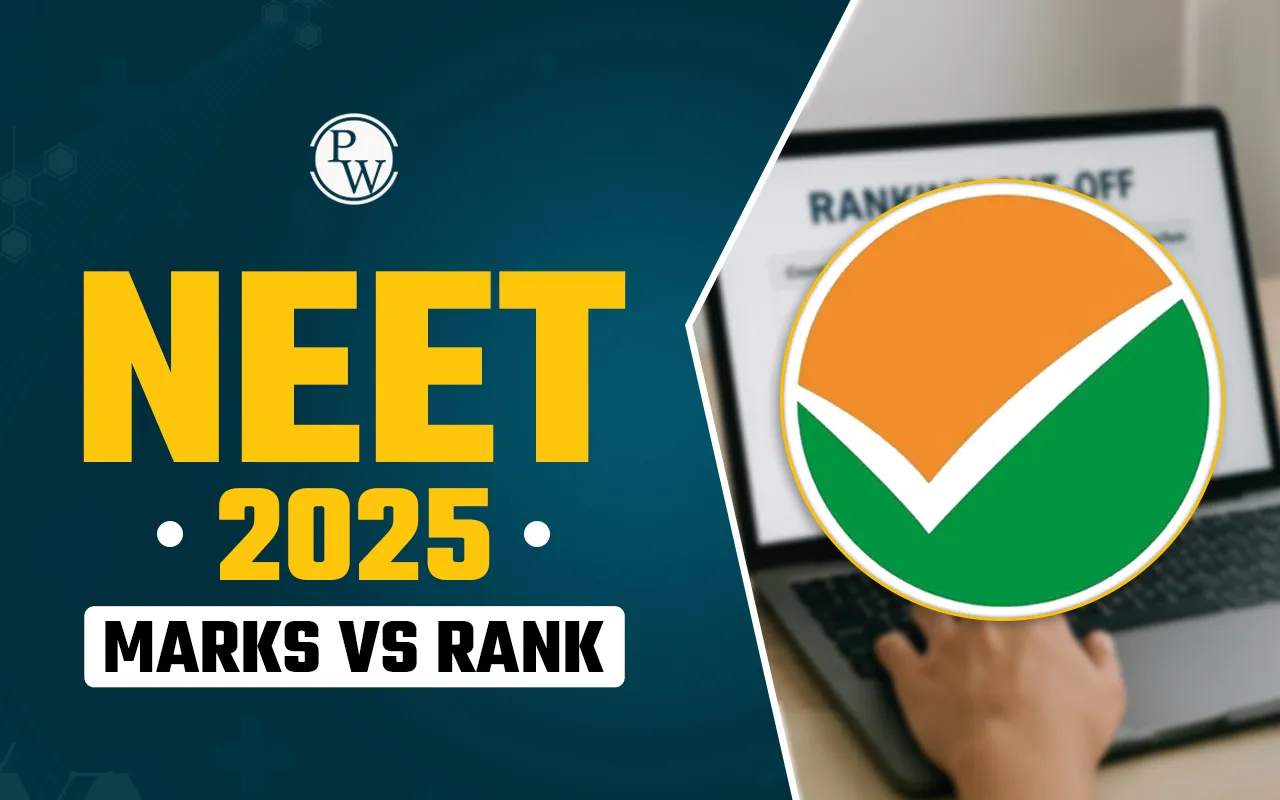
Muscular Tissue: Muscle tissue is a soft tissue and one of the four basic types of animal tissue. The human body contains about 600 muscles. These muscles serve many functions, including pumping blood, supporting movement, lifting heavy objects, and assisting in childbirth. Muscles contract and relax, causing movement. This movement can be voluntary (consciously controlled) or involuntary (occurs without conscious awareness).
Muscle tissue has unique properties that allow movement. Muscle cells are excitatory, which means they respond to stimuli. They are also contractile, which means they can shorten and exert a pulling force. When muscles are attached to two movable objects, such as bones, they contract and cause the bones to move.
Muscle tissue is divided into three categories based on structure and function: skeletal, cardiac, and smooth. Skeletal muscles are responsible for voluntary movements, cardiac muscles are located in the heart and pump blood, and smooth muscles are found in organs and perform involuntary movements. This article contains detailed information about muscle tissue, its types, and functions for the NEET Exam .
Structural organisation in Animals MCQ for NEET
Muscular Tissue Diagram
The diagram in the article below depicts various muscular tissues and is a valuable resource for NEET candidates studying animal structural organization animals in Class 11. It helps them understand the muscular tissues, which is important for their NEET exam preparation.
Muscular Tissue Location
Muscle tissue is found throughout the body, spanning from head to toe. Tendons connect skeletal muscles to bones and can be found in the arms, legs, abdomen, chest, back, and face. These muscles regulate voluntary movements like walking, running, and facial expressions.
Smooth muscles, also known as involuntary muscles, line the walls of internal organs like the stomach, intestines, bladder, and blood vessels. They aid in the movement of food through the digestive system, regulate urine flow, and constrict or dilate blood vessels to control blood pressure.
Cardiac muscle is only found in the heart and is responsible for pumping blood throughout the body. It works involuntarily to maintain circulation and ensure that oxygen and nutrients reach all tissues.
Tissues, Definition, Types of Animal Tissues and Functions
Muscular Tissue Types
Muscle tissue is a type of soft tissue that forms the majority of tissues found in the muscles of the human body. Alongside muscle tissue, muscles also contain connective tissues like tendons, which connect skeletal muscles to bones, and sheaths of connective tissue that surround muscle tissues. Only muscle tissue itself has cells capable of contracting. There are three main types of muscular tissue:
- Skeletal Muscle Tissue
- Smooth Muscle Tissue
- Cardiac Muscle Tissue
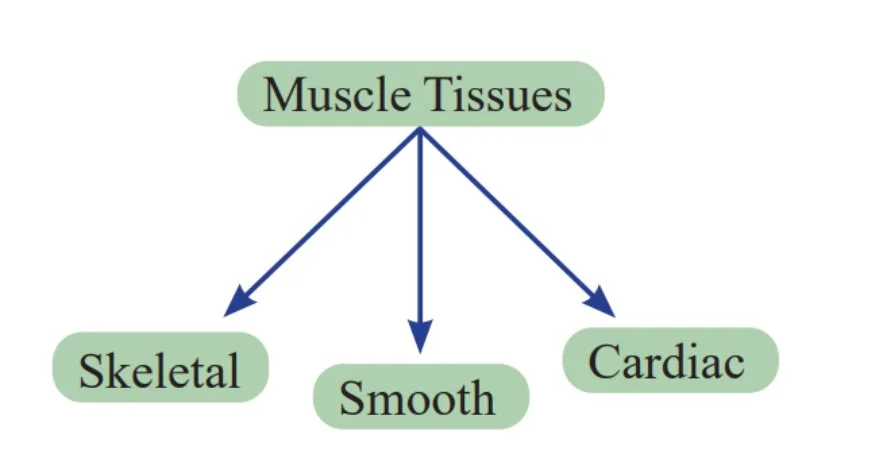
Epithelium Tissue, Types, Structure and Functions
Skeletal Muscle Tissue
Skeletal muscle accounts for approximately 40% of the body's mass and is essential for movement, facial expressions, posture, and voluntary actions. It attaches to bones and contracts to perform these functions. Skeletal muscle also plays an important role in thermal regulation by producing heat during contraction, particularly in shivering, an involuntary response to low body temperature.
Skeletal muscle cells, or myocytes, develop from myoblasts derived from the mesoderm layer and are organized into bundles surrounded by connective tissue. Under a light microscope, skeletal muscle cells appear striated due to the arrangement of contractile proteins actin and myosin, as well as structural proteins linking them to connective tissues. They are multinucleated, resulting from myoblast fusion during muscle fiber formation.
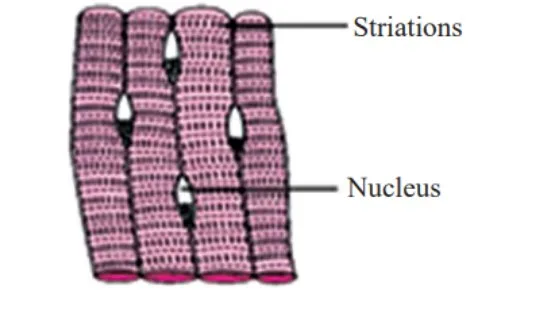
Nervous Tissue, Diagram, Types, Location, Functions and Nerves
Functions of Skeletal Muscle Tissue
The skeletal system, also known as the musculoskeletal system, has several functions:
- Support: It provides structural support for the body and serves as an attachment point for muscles and tendons.
- Movement: It facilitates movement by providing a framework for muscles to act upon.
- Protection: It protects internal organs from damage.
- Mineral storage: It stores minerals and fat, releasing them when needed.
- Blood cell production: It produces blood cells, primarily in the red marrow of bones.
- Endocrine regulation: It produces osteocalcin, a hormone that regulates cellular responses to insulin stimuli.
NEET Previous Year Question Papers
Smooth Muscle Tissue
Smooth muscle is a muscle tissue found in the walls of internal organs and structures such as blood vessels. It helps these organs and vessels function by contracting. Smooth muscles contract involuntarily, unlike skeletal muscles, which we can control. The autonomic nervous system, hormones, and other factors contribute to this. Smooth muscle cells, or myocytes, have actin and myosin filaments but are not organized in sarcomeres like skeletal muscles. Rather, they are staggered and alternate.
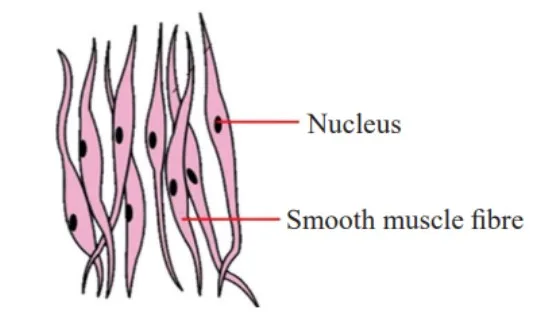
Functions of Smooth Muscle Tissue
Smooth muscle has several key functions in the body:
- Uterine Wall: It helps the uterus stretch during pregnancy and contract during childbirth.
- Contractions and Stretching: Unlike skeletal muscle, smooth muscle can sustain long contractions and stretch while maintaining its ability to contract.
- Control of Air Passages: It regulates the diameter of air passages, aiding in efficient respiration.
- Blood Flow and Pressure: It regulates blood flow and pressure by constricting or dilating blood vessels.
- Gastrointestinal Motility: It facilitates digestion by moving food through the digestive tract.
- Urinary System Function: It helps control the flow of urine in the urinary system.
- Lymphatic System Function: It propels lymph fluid through the lymphatic system.
- Control of Pupil Size: It regulates the size of the pupil in the eyes.
- Hair Erection: It raises hairs in hair follicles in the skin.
Cardiac Muscle Tissue
Cardiac muscle, made up of cells called cardiomyocytes, forms the contractile walls of the heart. These cells are striated and contain a single nucleus. Cardiomyocytes, unlike skeletal muscle, can contract spontaneously without external stimulation. Intercalated discs connect them with anchoring and gap junctions. This arrangement allows the cells to synchronize their contractions, resulting in long, branching fibers. The cardiac muscle pumps blood throughout the body and operates involuntarily.
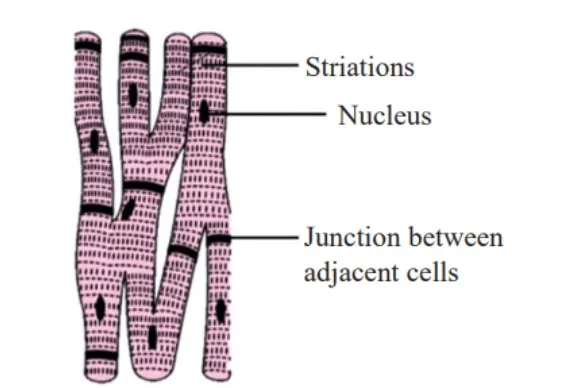
Functions of Cardiac Muscle Tissue
Functions of cardiac muscle include:
- Pumping Blood: It delivers oxygen and nutrients to cells and removes waste.
- Involuntary Movements: Contractions are automatic and cannot be controlled consciously.
- Rhythmic Contractions: Cardiac muscle contracts and relaxes rhythmically to pump blood.
- Contractility: It is responsible for the heart's ability to contract and pump blood.
- Cell Response: Cardiac muscle cells respond to nervous impulses.
- Locomotion: Involved in movement or locomotion.
- Excitation-Contraction Coupling: Links the muscle cell's action potential to contraction.
- Pacemaker Potentia l: Produced by changes in membrane permeability and currents.
Muscular Tissue Functions
Muscular tissues are tightly linked to nerve bundles, allowing the nervous system and muscles to communicate effectively. When a nerve impulse travels from the brain to the muscles, it causes a series of events that result in muscle contraction.
Actin and myosin are specialised proteins found inside each muscle cell. These proteins play an important role in muscular contraction. When a nerve signal reaches a muscle cell, it causes calcium ions to be released. These ions associate with the protein complex, allowing actin and myosin to interact.
During contraction, the actin and myosin filaments slide past one another, shortening the muscle fibre. A single muscle cell can shorten by up to 70% of its original size. When all of the muscle cells in a muscle contract simultaneously, the muscle shortens and moves.
Muscular tissues are necessary for a variety of bodily functions. They provide movement by pulling on bones, allowing us to walk, run, and do other activities. Muscles also help with organ squeezing and chamber compression, which aids digestion, blood circulation, and breathing.
Physics Wallah provides excellent NEET online coaching classes tailored for NEET candidates. The NEET Online Courses by PW includes live online sessions, extensive hardcopy study materials, and several tests. Join our NEET batch, led by highly qualified instructors. We offer various NEET batches in Hindi and English.
| NEET Exam Important Links | |
|---|---|
| NEET Biology Syllabus | NEET Biology Diagrams |
| NEET Biology MCQ | NEET Biology Chapter wise Weightage |
| NEET Exam Notes | NEET Previous Year Question papers |
Muscular Tissue FAQs
What is muscle tissue referred to as?
What are the three types of muscles?
What are the primary functions of muscular tissue?
Define tendon.
Explain smooth muscle.


